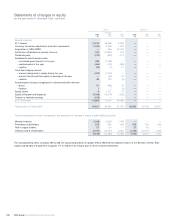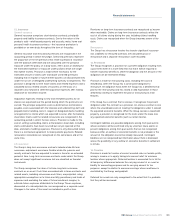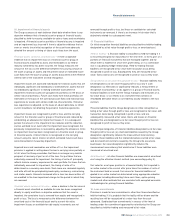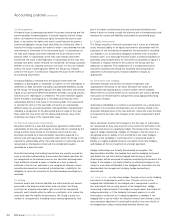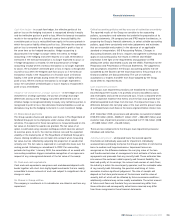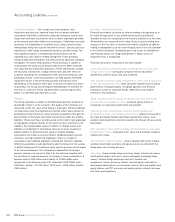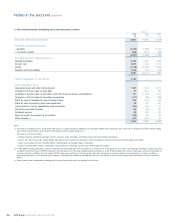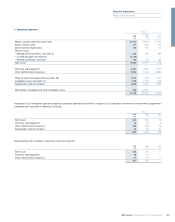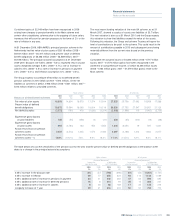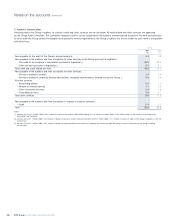RBS 2009 Annual Report Download - page 258
Download and view the complete annual report
Please find page 258 of the 2009 RBS annual report below. You can navigate through the pages in the report by either clicking on the pages listed below, or by using the keyword search tool below to find specific information within the annual report.RBS Group Annual Report and Accounts 2009256
Collective component – this is made up of two elements: loan
impairment provisions for impaired loans that are below individual
assessment thresholds (collectively assessed provisions) and for loan
losses that have been incurred but have not been separately identified
at the balance sheet date (latent loss provisions). Collectively assessed
provisions are established on a portfolio basis using a present value
methodology taking into account the level of arrears, security, past loss
experience, credit scores and defaults based on portfolio trends. The
most significant factors in establishing these provisions are the
expected loss rates and the related average life. These portfolios
include credit card receivables and other personal advances including
mortgages. The future credit quality of these portfolios is subject to
uncertainties that could cause actual credit losses to differ materially
from reported loan impairment provisions. These uncertainties include
the economic environment, notably interest rates and their effect on
customer spending, the unemployment level, payment behaviour and
bankruptcy trends. Latent loss provisions are held against estimated
impairment losses in the performing portfolio that have yet to be
identified as at the balance sheet date. To assess the latent loss within
its portfolios, the Group has developed methodologies to estimate the
time that an asset can remain impaired within a performing portfolio
before it is identified and reported as such.
Pensions
The Group operates a number of defined benefit pension schemes as
described in Note 4 on the accounts. The assets of the schemes are
measured at their fair value at the balance sheet date. Scheme liabilities
are measured using the projected unit method, which takes account of
projected earnings increases, using actuarial assumptions that give the
best estimate of the future cash flows that will arise under the scheme
liabilities. These cash flows are discounted at the interest rate applicable
to high-quality corporate bonds of the same currency and term as the
liabilities. Any recognisable surplus or deficit of scheme assets over
liabilities is recognised in the balance sheet as an asset (surplus) or
liability (deficit). In determining the value of scheme liabilities,
assumptions are made as to price inflation, dividend growth, pension
increases, earnings growth and employees. There is a range of
assumptions that could be adopted in valuing the schemes’ liabilities.
Different assumptions could significantly alter the amount of the surplus
or deficit recognised in the balance sheet and the pension cost charged
to the income statement. The assumptions adopted for the Group’s
pension schemes are set out in Note 4 on the accounts together with
the sensitivity of reported amounts to changes in those assumptions. A
pension asset of £58 million and a liability of £2,963 million were
recognised in the balance sheet at 31 December 2009 (2008: asset –
£36 million, liability – £2,032 million; 2007 asset – £575 million, liability –
£460 million).
Fair value – financial instruments
Financial instruments classified as held-for-trading or designated as at
fair value through profit or loss and financial assets classified as
available-for-sale are recognised in the financial statements at fair value.
All derivatives are measured at fair value. Gains or losses arising from
changes in the fair value of financial instruments classified as held-for-
trading or designated as at fair value through profit or loss are included
in the income statement. Unrealised gains and losses on available-for-
sale financial assets are recognised directly in equity unless an
impairment loss is recognised.
Financial instruments measured at fair value include:
Loans and advances (held-for-trading and designated as at fair value
though profit or loss) – principally comprise reverse repurchase
agreements (reverse repos) and cash collateral.
Debt securities (held-for-trading, designated as at fair value though profit
or loss and available-for-sale) – debt securities include those issued by
governments, municipal bodies, mortgage agencies and financial
institutions as well as corporate bonds, debentures and residual
interests in securitisations.
Equity securities (held-for-trading, designated as at fair value though
profit or loss and available-for-sale) – comprise equity shares of
companies or corporations both listed and unlisted.
Deposits by banks and customer accounts (held-for-trading and
designated as at fair value though profit or loss) – deposits measured at
fair value principally include repurchase agreements (repos), cash
collateral and investment contracts issued by the Group’s life assurance
businesses.
Debt securities in issue (held-for-trading and designated as at fair value
though profit or loss) – measured at fair value and principally comprise
medium term notes.
Short positions (held-for-trading) – arise in dealing and market making
activities where debt securities and equity shares are sold which the
Group does not currently possess.
Derivatives –these include swaps (currency swaps, interest rate swaps,
credit default swaps, total return swaps and equity and equity index
swaps), forward foreign exchange contracts, forward rate
agreements, futures (currency, interest rate and equity) and options
(exchange-traded options on currencies, interest rates and equities and
equity indices and OTC currency and equity options, interest rate caps
and floors and swaptions).
Accounting policies continued


